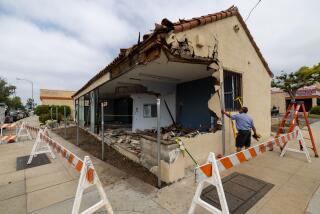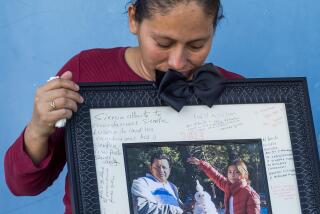Celebration Doubly Sobering
As a glassy-eyed millionaire, Jim Antonowitsch cruised the streets of Orange County in a beer-soaked haze on many nights. And evenings. And afternoons.
Itâs a blessing he never killed anyone, and Antonowitsch has tried to prove worthy of his divine grace by ditching the booze and using his wallet to help Orange Countyâs drug addicts and alcoholics.
Antonowitsch turned an Anaheim crack house into the Oasis Treatment Center, a spiritually based program that has rescued thousands of lives since first opening its doors 10 years ago today.
But when festivities begin this Wednesday to mark a decade of service, Antonowitsch and his wife, Kathleen, will find it hard to celebrate.
Last Oct. 30, their only son, Mark, an Army tank commander in the Gulf War and father of three, was killed when his motorcycle slammed into a car in an Anaheim intersection.
The other driver, Jose Enrique Sanchez of Anaheim, tested positive for cocaine and had been driving with a suspended license.
âI could have done exactly what this man had done,â Jim Antonowitsch, who has been sober 17 years, lamented recently. âI drove drunk. I never got busted, but that was luck.â
Beneath the Antonowitschsâ despair, however, is outrage and frustration with what they consider a failed legal system and a state law that treats drug-using drivers more leniently than it does people who have downed a few beers.
Sanchez, they learned, was arrested once before, in 1995, for cocaine use. Instead of his being sent to jail then, a Municipal Court judge ordered him to attend a drug treatment program--but Sanchez ignored the order, according to police and court records.
Now, because Anaheim police could not determine who ran the red light and caused the fatal accident, Sanchez faces only misdemeanor charges: being under the influence of cocaine and driving with a suspended license.
He was not charged with vehicular manslaughter or driving under the influence. Sanchez, 42, could face three years in prison but, if convicted, will likely spend only a few months behind bars, prosecutors told Antonowitsch.
âHe killed a man, and heâs going to get away with it,â Antonowitsch said. âDonât get me wrong, Iâm not after revenge. I just want him to take responsibility for what he did. Heâll kill again, heâll hurt again if heâs not treated for his own addiction.â
Antonowitsch knows all about addiction. He drank, heavily, for 24 years. On family trips to their mountain cabin in Running Springs, Antonowitsch would dust off a six-pack of beer before leaving his home in Santa Ana, and another six-pack as he drove. Once, he had 100 cases of beer stored in the garage.
That all changed in late 1981 when Internal Revenue Service auditors announced they were investigating his business dealings for the previous 12 years. After leaving the U.S. Navy in the late 1950s with only $1,200, Antonowitsch had amassed a fortune through a landscaping business and real estate investments in Orange County.
âMy whole life had been focused on two things: getting rich and drinking,â Antonowitsch said. âOnce I started drinking, I couldnât stop. I couldnât stop until I passed out.â
A business rival and drinking buddy tipped off the IRS after being subjected to Antonowitschâs drunken exaggerations about how he was raking in hundreds of thousands of dollars and skirting the tax collector. The IRS later dropped the case, finding no wrongdoing.
But for Antonowitsch, the prospect of losing everything was an epiphany. He quit drinking, and began serving as a mentor at Alcoholics Anonymous.
Rich enough to retire in his early 40s, Antonowitsch wanted to do more. So in 1988 he and his wife plowed $1 million into an Anaheim crack house on West Ball Road, near Disneyland, and transformed it into the Oasis Treatment Center to treat alcohol and drug dependency. It opened Feb. 28, 1989.
Today, the house rests in a grove of palms, complete with a swimming pool, rose garden and 12 stone steps leading to the front door, symbolizing the clinicâs adherence to Alcoholic Anonymousâ 12-step recovery program.
Oasis has treated more than 4,000 people from all walks of life. The 90-day program, which begins with a month of intensive residential treatment, often receives referrals from other clinics across the country, including the Betty Ford Center in Rancho Mirage.
On Wednesday, Oasis will celebrate the 10-year anniversary with a modest luncheon and testimonials from successful graduates.
One former resident will not be in attendance. Sheâs in jail for climbing behind the wheel of a car, while drunk, and killing another motorist in the Anaheim area. The Antonowitschs said the incident happened the same week their son was killed.
âThatâs what gets me so upset,â Kathleen Antonowitsch said. âAnyone else would have gone to jail, but the man who killed Mark . . . isnât.â
Mark Antonowitsch joined the Army at 17, in part to escape the reign of his alcoholic father, and spent 14 years in the military. Markâs tank company led the allied charge across Iraq during the Gulf War. He served in Bosnia, and earned a college degree from the University of Maryland while on active duty.
While stationed in Bremen, Germany, Mark married and became the father of three young boys. Following his discharge, he worked his way through Pacific West College of Law in Fullerton, and was scheduled to take the bar exam this month.
âWe knew it would be difficult, but Mark said he had to do it. He said it would be good for the family,â his widow, Daniela, said from Germany this week. âEverything we dreamed about was coming true. We would be together. He was about to become a lawyer.â
Laws Tougher on Drinking Than Drugs
On Oct. 30, three days before the couple were set to close on a new house in Orange, Mark dressed up as a motocross racer and was aboard his Kawasaki on the way to a Friday night Halloween party in Anaheim.
The collision happened just after 7 p.m. at Lincoln Avenue and Olive Street.
According to the Anaheim police investigation, Mark was traveling eastbound on Lincoln. Sanchez was driving north on Olive. Mark hit the Honda Accord at 40 mph. He never regained consciousness, and died the next day.
No one witnessed the collision, and police couldnât establish fault from the skid marks, debris and other evidence, according to the police report. But, according to the investigation, one of the drivers ran a red light.
Sanchez, through his attorney, said heâs sorry the Antonowitschs lost their son, but adamantly denied being high on cocaine or causing the collision.
Sanchez had the green light and the amount of cocaine found in his system was not enough to impair his driving ability, said defense attorney Amador Corona.
Under California law, if tests reveal a driver has a blood-alcohol level of .08% or more, the person is presumed to be driving under the influence. No similar blood-level standard applies to drugs.
Instead, prosecutors must prove--on a case-by-case basis--that drugs impaired a driverâs ability to operate a vehicle safely. That can be difficult to prove because of the wide range of physical and mental effects each drug can have on a person, said Mark Logan, spokesman for the Anaheim city attorneyâs office, which prosecutes misdemeanors.
Six other states--Arizona, Georgia, Illinois, Indiana, Minnesota and Utah--have adopted laws making it illegal for drivers to have any trace of illegal drugs in their system. In those states, drivers who test positive at any level are presumed to be driving under the influence.
Corona said he and the city attorneyâs office are negotiating a possible plea bargain, pending a background review on Sanchez and interviews with Mark Antonowitschâs parents by probation officers.
For Jim Antonowitsch, the most frustrating aspect of his sonâs death is that the other driver was a cocaine user who tossed away an opportunity to seek treatment.
Four years before Mark Antonowitsch was killed, Anaheim police arrested Sanchez outside Martin Luther Hospital in October 1995.
Sanchez was on cocaine and out of control, struggling with his wife as she tried to get him into the hospital emergency room, said Anaheim Police Department spokesman Sgt. Joe Vargas, one of the arresting officers.
Before the case went to trial, a Municipal Court judge ordered Sanchez to attend a drug treatment program, a common practice in drug cases. Had he completed the program, the drug charge would have been dropped.
Instead, Sanchez never attended. A bench warrant was issued for his arrest in March 1996.
Sanchez avoided arrest until crossing paths with Mark Antonowitsch on Oct. 30.
More to Read
Sign up for Essential California
The most important California stories and recommendations in your inbox every morning.
You may occasionally receive promotional content from the Los Angeles Times.











